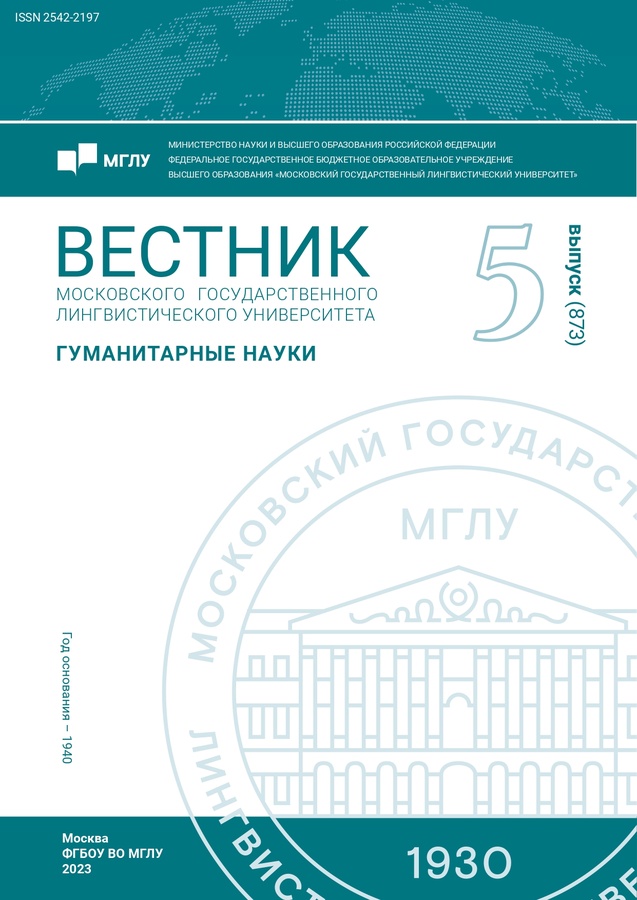Gesture Behavior when Generating an Ironic Statement: Gender Aspect
- Авторлар: Ryabukhina (Rashina) A.A.1
-
Мекемелер:
- Moscow State Linguistic University
- Шығарылым: № 5(873) (2023)
- Беттер: 100-106
- Бөлім: Linguistics
- URL: https://journal-vniispk.ru/2542-2197/article/view/351580
- ID: 351580
Дәйексөз келтіру
Толық мәтін
Аннотация
The article discusses the gender aspect of speech behavior when generating an ironic statement, as well as features of the gestural behavior of men and women when pronouncing irony in an oral spontaneous narrative. As a result of the empirical analysis, some tendencies were revealed in the gestures of men and women when generating an ironic statement, in particular, there was a quantitative predominance in the use of representative gestures, as well as a more frequent use of irony by men in an oral spontaneous narrative.
Негізгі сөздер
Авторлар туралы
Anastasia Ryabukhina (Rashina)
Moscow State Linguistic University
Хат алмасуға жауапты Автор.
Email: anastasiarashina@gmail.com
Postgraduate Student of the Department of General and Comparative Linguistics
РесейӘдебиет тізімі
- Zavrumov, Z. A. (2017). Fenomen ironii v hudozhestvennom tekste: pragmasemanticheskij i lingvokul’turologicheskij aspekty = The phenomenon of irony in a literary text: Pragmasemantic and linguistic and cultural aspects: Abstract of Senior Doctorate in Philology. Makhachkala. (In Russ.).
- Zaharova, M. V. (2020). Factors in the formation of an ironic context. In Vasil’ev, S. A. (ed.), Rusistika i komparativistika (issue XIV, pp. 103–118): collection of papers. Moscow: Knigodel. (In Russ.).
- Kozincev, A. G. (2007). Chelovek i smekh = Human and laughter. St.Petersburg: Aletejya. (In Russ.).
- Festinger, L. (2000). A theory of cognitive dissonance. St.Petersburg: Rech. (In Russ.).
- Gibbs, Jr., Raymond, W. (2000). Irony in talk among friends. Metaphor and symbol, 15(1–2), 5–27.
- Jorgensen, J. (1996). The functions of sarcastic irony in speech. Journal of Pragmatics, 26(5), 613–634.
- Leonovich, L. M., Kharkovskaya, A. A. (2016). Irony as a marker of the personages’ speech behavior in modern English drama discourse. Vestnik of Samara State University. History, pedagogics, philology, 1, 185–190. (In Russ.).
- Santiago, G. F., Victoria, E. V., Pilar, P. (2015). Gestural codas pave the way to the understanding of verbal irony. Journal of Pragmatics, 90, 26–47.
- Müller, C. (1998). Redebegleitende Gesten. Kulturgeschichte – Theorie – Sprachverleich. Berlin: Berlin Verlag.
- Cienki, A. (2013). Cognitive Linguistics: Spoken language and gesture as expressions of conceptualization. In Müller, C., Cienki, A., Ladewig, S., McNeill, D., Teßendorf, S. Body – Language – Communication: An international handbook on multimodality in human interaction (vol. 1, pp. 182–201). Berlin: Mouton de Gruyter.
- Bem, S. L. (1974). The measurement of psychological androgyny. Journal of Consulting and Clinical Psychology, 42, 155–162.
- Burns, R. (1986). Self-concept development and education. Moscow: Progress publishers. (In Russ.)
Қосымша файлдар










